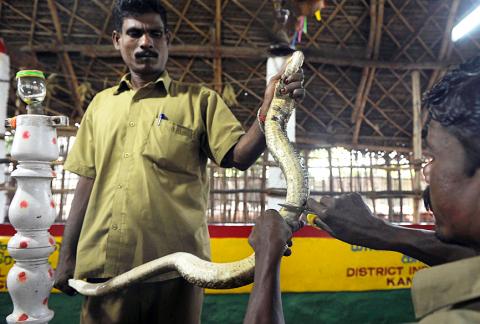A small scythe, a crowbar and a bundle of canvas bags are all that Kali and Vedan carry when they venture into the fields of southern India to catch some of the world’s deadliest snakes.
Their skills, passed from generation to generation of the Irula tribe they belong to, are crucial for the production of antivenom in a country with the world’s highest number of deaths from snake bites.
Since it began in the 1970s, the Irula snake catchers’ cooperative on the outskirts of the southern city of Chennai has revolutionized the treatment of snake bites in India, enabling it to produce enough antivenom to supply hospitals across the country.

Photo: AFP
It also provides much-needed income for the Irula, one of the region’s most deprived groups, who used to hunt snakes and sell the skins, but lost their livelihood overnight when India banned the practice in 1972.
Kali learned the intricate skill of tracking and then catching snakes from his father, whose abilities were renowned in the small community.
Now the 36-year-old uses those same skills to catch snakes for the cooperative, which keeps them for a month under license from the government and harvests their venom before returning them to nature.
This month he is tasked with catching the saw-scaled and Russell’s vipers — two of India’s four deadliest snake varieties — under the quota system the cooperative uses to ensure it harvests the right quantity of venom.
Within 20 minutes of starting the search in rice fields less than a kilometer from a busy highway, he has spotted a tiny snake concealed under the bark of a fence post, its brown markings barely visible against the wood.
Minutes later his partner Vedan has expertly maneuvered the slithering creature with his bare hands into a canvas bag, which he secures with a tight knot and slings into a plastic shopping basket.
“It’s an adult female saw-scaled viper, one of the most venomous snakes,” said Kali, who like many Indians goes by only one name. “In winter they like to hide in tree bark, that’s how we found it.”
Kali is to be paid 300 rupees (US$4.41) for the viper under a tariff system that rises to 2,500 rupees for a cobra.
Sometimes he gets lucky and finds a snake quickly; other times he will go for days without a catch, but the money is good, and unlike him, Kali’s children are able to attend school regularly.
The cooperative, which was established by the American conservationist Rom Whitaker and is now controlled by state authorities, will keep the snake for a month and harvest its venom four times.
Nonlethal amounts of venom from four snake species are injected into horses, which then produce antigens that are used to make antivenom for all bites.
That is the only reliable treatment for a human bitten by a venomous snake, although the Irula also use herbal treatments that they say give them more time to reach a hospital.
India has 244 snake species and the four most venomous — the cobra, krait, Russell’s viper and saw-scaled viper — are found throughout the country.
Experts said thousands of people die every year from snakebites in India, still a predominately rural economy where farmers run the risk of being bitten every time they go into their fields.
Government figures showed just a few recorded cases every year, but most go unreported because victims never reach hospitals and a 2011 study put the number of annual deaths at about 46,000.
Villagers living near the cooperative said snakes frequently entered their homes, putting them at risk of being bitten in their sleep — but were pretty nonchalant about the threat.
“In our village, one person was bitten by a snake. He was taken to hospital and he recovered,” said Maragadham, a 36-year-old child minder. “Snakes are found in most homes, but they are not a threat to us.”
That is because most health facilities in India now have sufficient supplies of antivenom.
Back at the cooperative, Kali and Vedan have placed their catch in a clay pot in preparation for the extraction process.
The extractor takes out the snake, gripping it below the head, which he places in front of a thin piece of leather that has been stretched over the top of a small glass jar to imitate skin.
As the snake opens its jaw and sinks its fangs into the leather covering, the deadly liquid drips into the jar.
“The snake has to bite, only then will it inject the venom,” explains R. Kumar after snipping a few scales from the snake’s skin to indicate that extraction has taken place. “We don’t have much education. We’re not interested in any other work, but this work is important, it is sacred to us.”

With much pomp and circumstance, Cairo is today to inaugurate the long-awaited Grand Egyptian Museum (GEM), widely presented as the crowning jewel on authorities’ efforts to overhaul the country’s vital tourism industry. With a panoramic view of the Giza pyramids plateau, the museum houses thousands of artifacts spanning more than 5,000 years of Egyptian antiquity at a whopping cost of more than US$1 billion. More than two decades in the making, the ultra-modern museum anticipates 5 million visitors annually, with never-before-seen relics on display. In the run-up to the grand opening, Egyptian media and official statements have hailed the “historic moment,” describing the

‘CHILD PORNOGRAPHY’: The doll on Shein’s Web site measure about 80cm in height, and it was holding a teddy bear in a photo published by a daily newspaper France’s anti-fraud unit on Saturday said it had reported Asian e-commerce giant Shein (希音) for selling what it described as “sex dolls with a childlike appearance.” The French Directorate General for Competition, Consumer Affairs and Fraud Control (DGCCRF) said in a statement that the “description and categorization” of the items on Shein’s Web site “make it difficult to doubt the child pornography nature of the content.” Shortly after the statement, Shein announced that the dolls in question had been withdrawn from its platform and that it had launched an internal inquiry. On its Web site, Le Parisien daily published a

China’s Shenzhou-20 crewed spacecraft has delayed its return mission to Earth after the vessel was possibly hit by tiny bits of space debris, the country’s human spaceflight agency said yesterday, an unusual situation that could disrupt the operation of the country’s space station Tiangong. An impact analysis and risk assessment are underway, the China Manned Space Agency (CMSA) said in a statement, without providing a new schedule for the return mission, which was originally set to land in northern China yesterday. The delay highlights the danger to space travel posed by increasing amounts of debris, such as discarded launch vehicles or vessel

RUBBER STAMP? The latest legislative session was the most productive in the number of bills passed, but critics attributed it to a lack of dissenting voices On their last day at work, Hong Kong’s lawmakers — the first batch chosen under Beijing’s mantra of “patriots administering Hong Kong” — posed for group pictures, celebrating a job well done after four years of opposition-free politics. However, despite their smiles, about one-third of the Legislative Council will not seek another term in next month’s election, with the self-described non-establishment figure Tik Chi-yuen (狄志遠) being among those bowing out. “It used to be that [the legislature] had the benefit of free expression... Now it is more uniform. There are multiple voices, but they are not diverse enough,” Tik said, comparing it